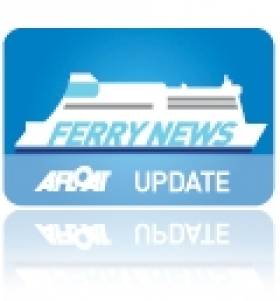Displaying items by tag: Newbuild news
Brand New Cargoship Makes Maiden ‘Irish’ Call to Namesake Port
#NEWBUILD VOYAGE- As previously reported on Afloat.ie Abis Dublin, a brand new multi-purpose heavy-cargoship made her maiden 'Irish' port of call to her namesake port yesterday, writes Jehan Ashmore.
The D-class 6,000 tonne newbuild had docked in Dublin Port having spent the previous night at anchor in Dublin Bay. On board the Dutch built vessel, operated by Abis Shipping, wind-turbine components could be seen at the aft end of the ship, noting her superstructure is located well forward close to the bow.
Abis Dublin was delivered earlier this month from shipbuilder's in Harlingen, where her owners are based and where the vessel is registered. Her first actual commercial sailing took place earlier this month, between Vlissingen to Emden, with an inaugural cargo of windmill components, which were later unloaded on arrival in Rouen. From the River Seine she then departed bound for Dublin, where the vessel is berthed alongside Ocean Pier.
Her sister Abis Dover, the leadship of the new class series made a call with B-class Abis Belfast last month, again to discharge windmill components. The latter vessel made a further call to the capital port just before Christmas, such activity reflecting the expanding Irish renewables energy sector.
Sister Powers On to Liverpool Route
#FREIGHT FERRY NEWS- Seatruck Power (2011/19,722grt) made her debut on the Dublin-Liverpool route last week, bringing an additional boost to freight capacity and follows her sister which only entered service in December, writes Jehan Ashmore.
The newbuild joins the leadship Seatruck Progress (see related report) on the central corridor service and another pair are due for completion by mid-year and are to be deployed on Seatruck's other Irish Sea routes.
The quartet, were all ordered from the Flensburger Schiffbau-Gesellschaft (FSG) yard in Germany. At 142m long, each of the 150-unit capacity newbuilds carry an additional 35 units compared to the 'P' class vessels, in which two of these vessels have been replaced from the Liverpool route.
Each sister has space for 2,166 lane freight metres spread across four decks, where on this particular deck hazardous and refrigerated cargo can be handled. They are also designed to carry rolling project cargo and heavy-lift items.

























































